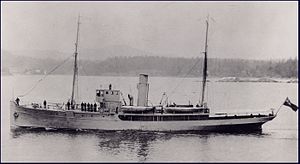Irish patrol vessel Muirchú
 HMCS Malaspina of the same design as the Muirchu
| |
| History | |
|---|---|
| Name | Helga II |
| Builder | Dublin Liffey Dockyard |
| Launched | 1908 |
| Christened | 1908 |
| Completed | July 1908 |
| Commissioned | 1915 |
| Renamed | Helga 1915 |
| Fate | Passed to Irish Free State |
| Name | Muirchú[1] |
| Namesake | Irish: Hound of the Sea |
| Builder | Dublin Liffey Dockyard |
| Acquired | 1923 |
| Commissioned | August 1923 |
| Decommissioned | 1947 |
| Renamed | August 1923 |
| Reclassified | 1923 |
| Fate | Sold to Hammond Lane Scrap Merchants Dublin, sank on delivery voyage.[1] |
| General characteristics | |
| Type | Steam yacht |
| Displacement | 323 tons |
| Length | 155 ft (47 m) |
| Armament |
|
| Notes | [2] |
Public Armed Ship Muirchú (Irish: [ˈmˠɪɾʲxuː]) was a ship in the service of Irish Free State's Coastal and Marine Service (CMS). She was the former Royal Navy ship HMY Helga and was involved in shelling Liberty Hall in Dublin from the River Liffey with her pair of 12-pounder naval guns[3] during the Easter Rising of 1916.
Helga was purchased by the Irish Free State in 1923 and renamed Muirchú, 'Hound of the Sea'.
She sank off the Wexford coast after disposal in 1947. The wheel was recovered from the wreck by local divers and can now be seen in Kehoes Pub in Kilmore Quay.[citation needed]
The prefix LÉ is sometimes mistakenly used with Muirchú. The prefix was introduced in December 1946 when the Irish Naval Service was established with the purchase of three corvettes from the Royal Navy replacing Muirchú.
Career
UK career
She was built in Liffey Dockyard in 1908[4] as a fishery research and protection cruiser and was named Helga II. Such was interest in her design that Canada ordered two ships to the same specification (HMCS Galiano and HMCS Malaspina).[5]
She was then under control of the Department of Agriculture and Technical Instruction (Ireland) until she was taken over by the
Helga was involved in the Easter Rising when British forces used her to shell areas around Dublin, including Liberty Hall, in April 1916.[7] In April 1918 she was credited with the sinking of a submarine off the Isle of Man and for the remainder of her career she carried a star on her funnel as an indicator of this,[6] even though no submarine was recorded as being sunk in the area at that time.[8][citation needed]
In October of the same year RMS Leinster was torpedoed off the Kish and 517 were lost. Helga was fuelling in Dún Laoghaire[6] at the time. She rescued ninety of the passengers. Helga was released from the navy in March 1919 and returned to fisheries work. She was later used to transport Royal Irish Constabulary special constables known as Black and Tans around the coast when many of the roads in Ireland were rendered impassable by the IRA in the War of Independence.
Irish service
Helga was handed over to the
However, in the following year the vessel was returned to the Department of Agriculture and Fisheries to carry on her task of fishery protection. It was not until the actual day on which the
Muirchú was sold to Hammond Lane Foundry by the Irish Government, and while on passage to Dublin on 8 May 1947 she sank off the Saltee Islands – though not before her crew safely evacuated.
Notes
- ^ Collins p145
- ISBN 978-1-59114-818-0.
- JSTOR 25573628(registration required)
- ^ Collins p147
- ^ a b c "The Helga 11 (Muirchu)". www.irishships.com. Retrieved 17 December 2023.
- ^ Townshend, Charles. Easter 1916: The Irish Rebellion.
- ISBN 0-9549186-0-6.
Bibliography
- Zolandez, Thomas (2004). "Question 42/99: Irish Gunboat Muirchu". Warship International. XLI (4): 348–349. ISSN 0043-0374.

